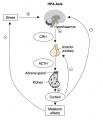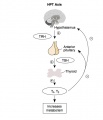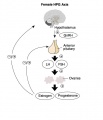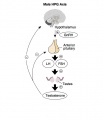File:HPA axis.jpg
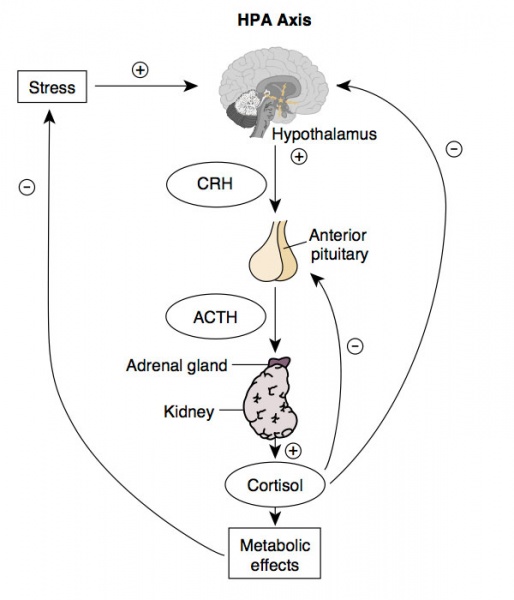
Original file (600 × 700 pixels, file size: 46 KB, MIME type: image/jpeg)
Hypothalamus - Pituitary - Adrenal Endocrine Axis
Schematic representation of the HPA axis.
- The hypothalamus secretes releasing hormone (CRH) that act on the pituitary gland.
- In response to this stimuli, the pituitary gland releases ACTH.
- ACTH activates the adrenal glands to release cortisol, which induces metabolic effects.
- Cortisol also acts back on the hypothalamus and pituitary gland by negative feedback.
- + stimulates
- - inhibits
- Links: Image - HPA | Hypothalamus | Pituitary | Adrenal | Image - HPT Axis | Thyroid | Image - HPG female | Image - HPG male | Gonad
Hypothalamus
The hypothalamus is a small region located within the brain that controls many bodily functions, including eating and drinking, sexual functions and behaviors, blood pressure and heart rate, body temperature maintenance, the sleep-wake cycle, and emotional states (e.g., fear, pain, anger, and pleasure). Hypothalamic hormones play pivotal roles in the regulation of many of those functions. Because the hypothalamus is part of the central nervous system, the hypothalamic hormones actually are produced by nerve cells (i.e., neurons).
Pituitary
The anterior pituitary produces several important hormones that either stimulate target glands (e.g., the adrenal glands, gonads, or thyroid gland) to produce target gland hormones or directly affect target organs. The pituitary hormones include adreno-corticotropic hormone (ACTH); gonadotropins; thyroid-stimulating hormone (TSH), also called thyrotropin; growth hormone (GH); and prolactin.
The first three of those hormones (ACTH, gonadotropins, and TSH) act on other glands.
- ACTH stimulates the adrenal cortex to produce corticosteroid hormones (primarily cortisol) as well as small amounts of female and male sex hormones.
- Gonadotropins comprise two molecules, luteinizing hormone (LH) and follicle-stimulating hormone (FSH). These two hormones regulate the production of female and male sex hormones in the ovaries and testes as well as the production of the germ cells (oocyte and spermatozoa).
- TSH stimulates the thyroid gland to produce and release thyroid hormone.
The remaining two pituitary hormones, GH and prolactin, directly affect their target organs.
Adrenal
The adrenal cortex produces numerous hormones, primarily corticosteroids (i.e., glucocorticoids and mineralocorticoids). The cortex is also the source of small amounts of sex hormones; those amounts, however, are insignificant compared with the amounts normally produced by the ovaries and testes. The adrenal medulla generates two substances—adrenaline and noradrenaline—that are released as part of the fight-or-flight response to various stress factors.
- cortisol (hydrocortisone), which helps control carbohydrate, protein, and lipid metabolism.
(text modified from publication)
Reference
<pubmed>15706790</pubmed>| PDF
Copyright
Unless otherwise noted in the text, all material appearing in this journal is in the public domain and may be reproduced without permission. Citation of the source is appreciated.
File history
Click on a date/time to view the file as it appeared at that time.
| Date/Time | Thumbnail | Dimensions | User | Comment | |
|---|---|---|---|---|---|
| current | 16:51, 15 May 2012 |  | 600 × 700 (46 KB) | Z8600021 (talk | contribs) | Hypothalamus - Pituitayr - Adrenal Endocrine Axis== ===Reference=== <pubmed>15706790</pubmed> Unless otherwise noted in the text, all material appearing in this journal is in the public domain and may be reproduced without permission. Citation of t |
You cannot overwrite this file.
File usage
The following 10 pages use this file:
